
Aquila is a constellation on the celestial equator. Its name is Latin for 'eagle' and it represents the bird that carried Zeus/Jupiter's thunderbolts in Greek-Roman mythology.
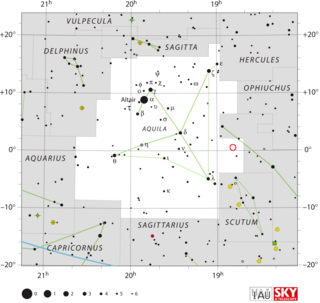
V603 Aquilae was a bright nova first observed in the constellation Aquila in 1918. It was the brightest "new star" to appear in the sky since Kepler's Supernova in 1604. Like all novae, it is a binary system, comprising a white dwarf and donor low-mass star in close orbit to the point of being only semidetached. The white dwarf sucks matter off its companion, which has filled its Roche lobe, onto its accretion disk and surface until the excess material is blown off in a thermonuclear event. This material then forms an expanding shell, which eventually thins out and disappears.

T Aurigae was a nova, which lit up in the constellation Auriga in 1891. Thomas David Anderson, an amateur astronomer in Edinburgh, reported that he was "almost certain" he saw the nova at 02:00 UT on 24 January 1892, when it was slightly brighter than χ Aurigae. He mistook the star for 26 Aurigae, although he noted to himself that it seemed brighter than he remembered it being. He saw it twice more during the following week. On 31 January 1892 he realized his mistake, and wrote a note to Ralph Copeland reporting his discovery. Professor Copeland immediately reported the discovery via telegram to William Huggins, who made the first spectroscopic observations of T Aurigae on 2 February 1892, when the star was a magnitude 4.5 object. T Aurigae was the first nova to be observed spectroscopically.
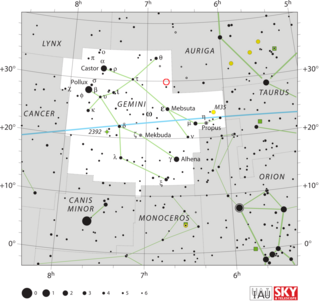
DM Geminorum also known as Nova Geminorum 1903 was a nova which erupted in the constellation Gemini in 1903. It was discovered by Herbert Hall Turner at the Greenwich Observatory on a Carte du Ciel photographic plate taken on 16 March 1903. Post-discovery examination of earlier photographs of the region taken at the Harvard College Observatory showed that the star was fainter than apparent magnitude 9 on 2 March 1903, and magnitude 5.1 on 6 March 1903, making it visible to the naked eye at that time. It had a conspicuous red color due to strong Hα line emission. By 1 April 1903 it had faded to magnitude 8.5. By 1989 it had reached visual magnitude 17.38.
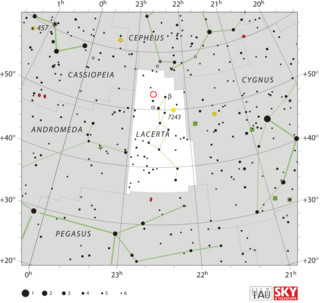
DI Lacertae or Nova Lacertae 1910 was a nova in constellation Lacerta which appeared in 1910. It was discovered by Thomas Henry Espinell Compton Espin at Wolsingham Observatory on 30 Dec 1910, at which time it was an 8th magnitude object. Subsequent examination of pre-discovery photographic plates showed that the outburst occurred sometime between 17 November 1910 and 23 November 1910. It reached a peak brightness of magnitude 4.6 on 26 November 1910, making it visible to the naked eye. Before the nova event DI Lacertae was a 14th magnitude star, and by 1950 it had returned to 14th magnitude.
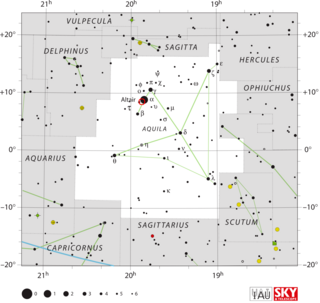
V500 Aquilae also known as Nova Aquilae 1943 was a nova which appeared in the constellation Aquila, very near the star Altair, in 1943. It was discovered by Cuno Hoffmeister on photographic plates taken at Sonneberg Observatory on 5 September 1943, when it had a photographic magnitude of 12. It reached its peak brightness sometime between 13 April 1943 when it was fainter than photographic magnitude 13.5, and 2 May 1943 when its photographic magnitude was 6.55.

HR Lyrae or Nova Lyrae 1919 was a nova which occurred in the constellation Lyra in 1919. Its discovery was announced by Johanna C. Mackie on 6 December 1919. She discovered it while examining photographic plates taken at the Harvard College Observatory. The bulletin announcing the discovery states "Between December 4 and 6 it rose rapidly from the sixteenth magnitude or fainter, to a maximum of about 6.5". It was the first nova ever reported in Lyra, and Mackie was awarded the AAVSO gold medal for her discovery. Its peak magnitude of 6.5 implies that it might have been visible to the naked eye, under ideal conditions.
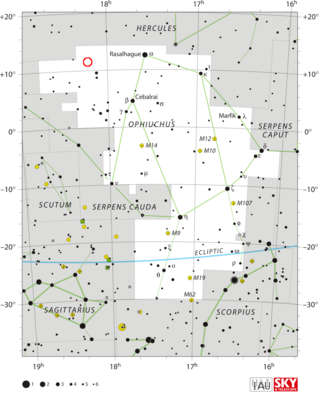
V849 Ophiuchi or Nova Ophiuchi 1919 was a nova that erupted in 1919, in the constellation Ophiuchus, and reached a blue band brightness of magnitude 7.2. Joanna C. S. Mackie discovered the star while she was examining Harvard College Observatory photographic plates. The earliest plate it was visible on was exposed on August 20, 1919, when the star was at magnitude 9.4. It reached magnitude 7.5 on September 13 of that year. In its quiescent state it has a visual magnitude of about 18.8. V849 Ophiuchi is classified as a "slow nova"; it took six months for it to fade by three magnitudes.

V604 Aquilae or Nova Aquilae 1905 is a nova which was first observed in the constellation Aquila in 1905 with a maximum brightness of magnitude 7.6. It was never bright enough to be seen with the naked eye. It was discovered by Williamina Fleming on a Harvard College Observatory photographic plate taken on August 31, 1905. Examination of plates taken earlier indicates that peak brightness occurred in mid-August 1905. The star's quiescent visual band brightness is 19.6.

V373 Scuti was a nova which appeared in 1975 in the southern constellation of Scutum. It was announced on June 15, 1975 by Paul Wild at the Zimmerwald Observatory, Switzerland. At the time the magnitude was about 7.9. The peak magnitude of 7.1 occurred a month earlier on May 11.
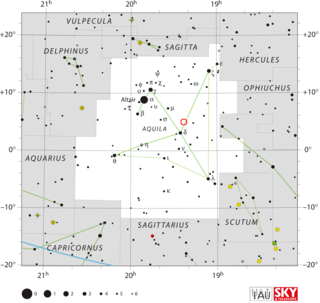
V1494 Aquilae or Nova Aquilae 1999 b was a nova which occurred during 1999 in the constellation Aquila and reached a brightness of magnitude 3.9 on 2 December 1999. making it easily visible to the naked eye. The nova was discovered with 14×100 binoculars by Alfredo Pereira of Cabo da Roca, Portugal at 18:50 UT on 1 December 1999, when it had a visual magnitude of 6.0.

V1059 Sagittarii was a nova, which lit up in 1898 in the constellation Sagittarius. The star reached apparent magnitude 4.5, making it easily visible to the naked eye. It was discovered on 8 March 1898, by Williamina Fleming on a photographic plate taken at the Harvard College Observatory. The discovery plate was an objective prism plate, part of the Henry Draper Memorial Photographs, and Ms Fleming identified it as a nova based on its spectral characteristics.
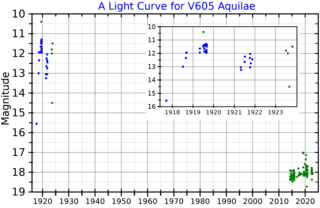
V605 Aquilae, in the constellation Aquila, is the variable central star of the planetary nebula Abell 58. It is a highly unusual hydrogen-deficient carbon-rich star.
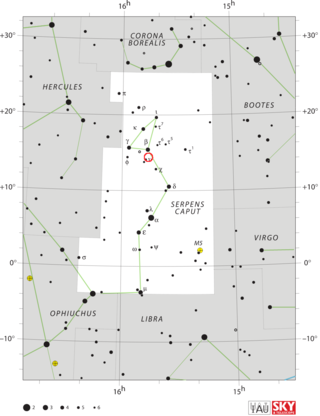
CT Serpentis was a nova that appeared in the constellation Serpens in 1948. It was discovered by Ramze Alexander Bartaya at Abastumani Observatory on 9 April 1946. It is thought to have reached magnitude 6.0, but this is an extrapolation of its light curve as it was not observed until 9 April 1948 when it was at magnitude 9.0 and fading—clearly past its maximum.

V630 Sagittarii was a nova visible to the naked eye in 1936. It was discovered on 3 October 1936 by Shigeki Okabayashi of Kobe, Japan when it had an apparent magnitude of 4.5.
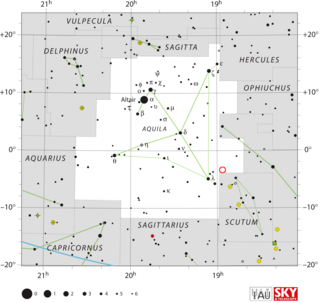
EL Aquilae, also known as Nova Aquilae 1927 was a nova that appeared in 1927. It was discovered by Max Wolf on photographic plates taken at Heidelberg Observatory on 30 and 31 July 1927 when it had a photographic magnitude of 9. Subsequent searches of plates taken at the Harvard College Observatory showed the nova was fainter than magnitude 11.1 on 8 June 1927 and had flared to magnitude 6.4 on 15 June 1927. It declined from peak brightness at an average rate of 0.105 magnitudes per day, making it a fast nova, and ultimately dimmed to about magnitude 21. The 14.5 magnitude change from peak brightness to quiescence was unusually large for a nova.

V368 Aquilae, also known as Nova Aquilae 1936 no. 2 was the second nova which occurred in the constellation of Aquila during 1936. It was discovered on a photographic plate by Nils Tamm at Kvistaberg Observatory on 7 October 1936. At the time of discovery it was at photographic magnitude 7, and was already fading. Pre-discovery photographs showed that peak brightness occurred around 25 September 1936, at which time it had reached apparent magnitude 5.0, making it visible to the naked eye. The nova was described as being fiery red due to strong Hα emission, and for a time could be seen with binoculars simultaneously with V356 Aquilae, another nova which Nill Tamm had discovered a month earlier.
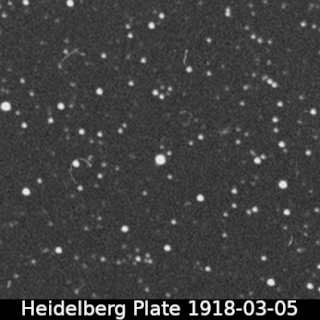
GI Monocerotis, also known as Nova Monocerotis 1918, was a nova that erupted in the constellation Monoceros during 1918. It was discovered by Max Wolf on a photographic plate taken at the Heidelberg Observatory on 4 February 1918. At the time of its discovery, it had a photographic magnitude of 8.5, and had already passed its peak brightness. A search of plates taken at the Harvard College Observatory showed that it had a photographic magnitude of 5.4 on 1 January 1918, so it would have been visible to the naked eye around that time. By March 1918 it had dropped to ninth or tenth magnitude. By November 1920 it was a little fainter than 15th magnitude.

V1370 Aquilae, also known as Nova Aquilae 1982, is a nova that appeared in the constellation Aquila during 1982. It was discovered by Minoru Honda of Kurashiki, Japan at 20:30 UT on 27 January 1982. At that time the Sun had moved just far enough from Aquila to allow the nova to be seen in the morning sky. Although it was discovered photographically, its apparent magnitude was 6–7, making it potentially visible to the naked eye under ideal conditions. A possible magnitude 20 progenitor was located on the Palomar Sky Survey prints. Spectra of the object were taken in February 1982 at Asiago Astrophysical Observatory, which confirmed that it is a nova.

OY Arae, also known as Nova Arae 1910, is a nova in the constellation Ara. It was discovered by Williamina Fleming on a Harvard Observatory photographic plate taken on April 4, 1910. At that time it had a magnitude of 6.0, making it faintly visible to the naked eye under ideal observing conditions. Examination of earlier plates showed that before the outburst it was a magnitude 17.5 object, and by March 19, 1910, it had reached magnitude 12.





















